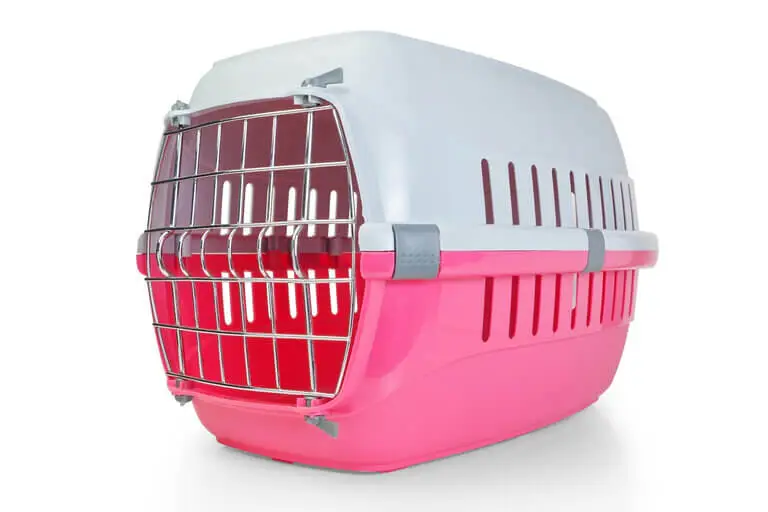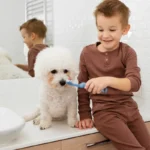Deciding whether to get a dog crate for your Labrador puppy is the first step in welcoming this energetic bundle of joy into your home. Known for their boundless energy and playful nature, Labrador puppies are among the most popular dog breeds for families.
Table of Contents
- The Benefits of Crate Training for Labrador Puppies
- Choosing the Right Crate Size for Your Labrador Puppy
- Types of Crates for Labrador Retrievers
- Crate vs. Room at Night: The Great Debate
- Do Lab Puppies Sleep Through The Night?
- Conclusion
Crate training can offer numerous benefits that provide a safe haven for your puppy and aid in-house training. It helps in preventing destructive behaviors when they cannot be supervised. For both puppies and owners, the right dog crate serves as a comforting den where your Labrador can retreat and relax, instilling a sense of security and belonging.
You can never go wrong with a crate. In fact, according to the AKC, veterinarians, breeders, and trainers collectively recommend crate training dogs from a young age. By integrating a dog crate into your routine, you’re not just managing your puppy’s environment; you’re setting the stage for a well-behaved adult dog.
The Benefits of Crate Training for Labrador Puppies
There are numerous benefits of crate training your Labrador puppy, and any other puppy.
It is a Way of Potty Training
Crates are invaluable in teaching your Labrador puppy where and when to go to the bathroom. Since puppies usually avoid soiling their sleeping area, a crate limits their space, encouraging them to hold it until they’re taken outside. It accelerates housebreaking and establishes a routine, making the training process smoother for both you and your pup.
Crates offer Security and Comfort
For a young Labrador, a crate mimics the den-like space they instinctively seek for relaxation. It helps reduce anxiety and promote calmness, especially in a new environment or when experiencing loud noises and unfamiliar situations. The crate slowly becomes their haven, where they feel protected and at ease.
Prevents Destructive Chewing
Puppies, with their exploratory nature and teething tendencies, often resort to chewing as a form of relief and discovery. By confining your Labrador puppy to a crate when unsupervised, you can prevent potential destruction, particularly of household items that could be harmful if ingested. If your puppy likes chewing, consider getting them these dog bones for chewers.
Safer Travel Option
Whether it’s a short trip to the vet for vaccinations, a drive as you head out for outdoor activities, or a long family vacation, a crate keeps them safe. Getting your Labrador puppy used to a crate can make car journeys safer and more comfortable. It restricts their movement in the vehicle, preventing distractions, and provides them with a sense of familiarity and security during travel.
Routine Establishment
There is a routine establishment that comes with crate training. A crate helps set a daily schedule for sleeping, playtime, and potty breaks. This predictability helps your Labrador puppy adjust to your household’s rhythm, leading to a happier, more well-behaved dog.
Ease of Supervision
Lastly, crates offer ease of supervision, especially for Labradors. Labrador puppy owners need to keep a vigilant eye at all times. As easy as it sounds, it can be pretty challenging, especially when balancing other household or professional responsibilities.
A crate helps localize your puppy to a specific area, making it easier to monitor their activities and behavior. This control is particularly beneficial during the puppy stage when they’re most susceptible to getting into trouble or accidentally putting themselves in danger. By knowing exactly where your puppy is and what they’re doing, you can ensure their safety and well-being, providing peace of mind for both you and your family.
In essence, a crate is more than just a training tool; it’s a pivotal component in shaping a healthy and happy relationship with your Labrador puppy, ensuring their safety, comfort, and well-being. Like anything else, crate training will have its downsides, too, and we thought it best if you could get first-hand downside experiences from other dog owners.
Choosing the Right Crate Size for Your Labrador Puppy
Deciding on what size crate I need for a labrador puppy? Size is crucial for ensuring their comfort and safety. Your pup should have enough room inside the crate to stand up, turn around, and lie down without feeling cramped.
A crate that’s too small can make your Labrador feel uncomfortable and anxious. On the contrary, one that’s too big might not provide the sense of security they need. A smart way to get the most out of your investment is by choosing a crate with a divider panel. The panel allows you to adjust the crate’s size as your puppy grows.
When your pup is little, you can use the divider to create a snugger area that feels cozy and safe. As your puppy grows bigger, you can move or remove the divider to give them more space. This way, the same crate can serve your Labrador from puppyhood into adulthood without having to buy multiple crates of different sizes.
Should You Crate Your Labrador Puppy?
Should I crate my Labrador puppy? A simple question that can stir up mixed feelings, especially with common concerns around crate training potentially being cruel. It’s crucial to clear up this misconception. Crate training, when done properly, is not cruel. In fact, it leverages a dog’s natural instinct to seek a safe and secure den-like area where they can relax and sleep.
The key lies in using the crate positively, ensuring it’s a happy place your puppy wants to be. Still unsure of whether to crate your little baby? Here is a comparison between a crate and a kennel that might help you decide.
Types of Crates for Labrador Retrievers

When it comes to selecting the perfect crate for your Labrador retriever, understanding the different types of crates available is essential. The common question, “What type of crate is best for a Labrador retriever?” often arises among new pet owners. To answer this, we must consider the various materials from which crates are made.
- Wire Crates are the most popular choice among Labrador owners. Their key advantages include excellent ventilation and visibility, allowing your puppy to see its surroundings and feel more comfortable. These crates are also sturdy and can be equipped with a divider panel, making them adaptable as your Labrador grows.
- Plastic Crates stand out for their ease of cleaning and durability. They are particularly good for travel, providing a secure and enclosed environment for your pup. Their solid construction might offer a cozy den-like feel, which some dogs prefer.
- Soft Crates are known for being portable and lightweight, making them an ideal choice for Labrador owners on the go. However, they may not withstand the enthusiastic chewing and scratching of a spirited Labrador puppy, potentially leading to durability concerns.
For a Labrador retriever, I recommend opting for a wire crate equipped with a divider panel. It is the best choice because of its versatility and adaptability. The wire crate’s open design helps prevent your Lab from feeling isolated while ensuring proper airflow, which is particularly beneficial in warmer climates or during hot seasons. Additionally, the inclusion of a divider panel is a financially savvy move—it grows with your dog, making it a worthwhile investment.
Crating Your Puppy for the First Time?- Tips for You
Successfully crate training your Labrador puppy requires patience, consistency, and the use of positive reinforcement. Begin by introducing the crate gradually, making it a rewarding experience with the help of treats and their favorite toys. The positive association will encourage your puppy to enter the crate willingly. However, successful crate training might have a different meaning. Here is a discussion of what different Labrador puppy owners consider successful in their puppy’s crate training.
When starting, use the crate for short periods. Start with just a few minutes at a time and gradually increase as your puppy gets more comfortable. It will encourage your puppy to see the crate as its special place rather than a cage. Overusing the crate or keeping a puppy confined for too long can lead to anxiety. Remember, the crate is a tool for management and training, not punishment.
Understanding the benefits of crate training can contribute to your Labrador puppy’s development. It creates a foundation of security and good habits from the start. By addressing common concerns and emphasizing the crate’s positive use, you’re paving the way for a happy, well-behaved adult Labrador. Crate training, with the right approach, stands as a testament to responsible and caring pet ownership, ensuring the well-being of your furry friend.
Is There an Alternative?
Yes. There are alternative methods for managing your puppy, like puppy gates, which can confine them to puppy-proof parts of your home. These can be great in some situations, allowing more freedom while still limiting access to the whole house.
However, they don’t offer the same level of security, comfort, and training benefits that a well-utilized crate does. The crate helps with potty training, prevents destructive behaviors when unsupervised, and makes travel safer and more comfortable for your puppy.
How Long Can a Lab Puppy Stay in Crate?
A general guideline for crate duration is based on your puppy’s age in months: a puppy can stay in a crate for approximately one hour for every month of age. For example, a 2-month-old puppy should not be left in a crate for more than 2 hours at a time.
Nevertheless, this rule is flexible and must be adapted to your puppy’s individual needs and tolerance. Always provide opportunities for breaks, exercise, and elimination every few hours, especially for younger puppies who cannot hold their bladder for long periods.
It’s important to remember that every puppy is unique, and their ability to stay in a crate without becoming anxious or stressed differs. Some puppies may be able to stay in a crate longer than others of the same age. Observe your puppy’s behavior and adjust accordingly for a successful crate training experience.
Crate vs. Room at Night: The Great Debate
When it comes to deciding where your Labrador puppy should sleep at night – in a crate or a room – there are several factors to consider. Each option has its pros and cons, and the best choice depends on your puppy’s age, temperament, and training level.
Crate
Pros:
- Promotes Crate Training: Using a crate at night aligns with daily crate training practices, reinforcing the concept that the crate is a safe, personal space for your puppy.
- Prevents Accidents: A crate limits the space your puppy has access to, reducing the likelihood of potty accidents at night since puppies typically avoid soiling in their sleeping area.
- Provides Security: Crates offer a sense of security, as the enclosed environment mimics a den-like space where puppies can feel protected and at ease.
Cons:
- Limited Space: Crates confine puppies to a small area, which can be problematic if they are anxious or dislike confinement.
- Training Required: Some puppies may initially resist crate training, requiring persistence and patience from the owner.
Room
Pros:
- More Freedom: Allowing your Labrador to sleep in a room gives them more space to move around and get comfortable, which might be preferable for older, housebroken puppies.
- Less Confinement: Puppies with a dislike for enclosed spaces may respond better to being left in a room where they don’t feel as confined.
Cons:
- Risk of Accidents: With more freedom comes a higher risk of potty accidents, especially for puppies that are not yet housebroken.
- Potential Destructive Behavior: Puppies might chew on furniture or get into things they shouldn’t when left unattended in a room.
For Labrador puppy owners, I recommend starting with crate training. It introduces structure, aids in potty training, and helps your puppy develop a sense of security within their own space. Starting with a crate also allows you to monitor how your puppy adapts to being left alone at night. It also gives you the flexibility to gradually transition them to sleeping in a room as they mature and show signs of reliable house behavior and less destructive tendencies.
Consider transitioning to a room once your Labrador is consistently well-behaved during the night. They might be ready if they no longer have accidents or chew on inappropriate items. Even then, the transition should be gradual, perhaps starting with extended periods during the day, to ensure your puppy adjusts well. It is also important to maintain the nighttime habits of going to the bathroom outside and sleeping through the night.
Ultimately, base your decision on what makes your puppy most comfortable and what aligns with your training goals and daily routine. Both options require observation and adjustment according to how your Labrador puppy responds.
Do Lab Puppies Sleep Through The Night?

It’s a common question among new Labrador puppy owners. Initially, the answer is usually no. Puppies, much like human infants, have smaller bladders and need to eat more frequently, so they often require at least one nighttime break. Therefore, for the first few months, your Lab puppy might not sleep through the night without needing to go outside.
When it comes to nighttime crate crying, it’s essential to understand that it’s normal for puppies to cry in their crate at night during the early days of training. This crying can be their way of adjusting to the new environment or signaling a need to go potty.
Is It OK To Let A Puppy Cry In Crate At Night?
If the crying is brief and infrequent, it’s generally considered part of the learning process. However, prolonged or distressed crying may indicate that your puppy is not yet comfortable in its crate or needs to relieve itself.
To manage nighttime crying, establishing a consistent crate routine is vital. Here are tips for helping your Lab puppy (and you) get a better night’s sleep:
- Provide a potty break before bed: Ensure your puppy goes to the bathroom right before bedtime. This can help them feel more comfortable throughout the night and potentially sleep longer.
- Create a soothing environment: Including a soft blanket or a toy that doesn’t pose a choking hazard can make the crate feel more inviting and secure.
- Keep the crate close: If possible, place the crate in your bedroom or nearby so your puppy doesn’t feel isolated. Being able to hear your presence can be comforting.
- Resist the urge to respond to every cry: If you’ve ensured that your puppy’s needs are met (they’ve been to the bathroom, they’re not too cold or too hot, etc.), try to wait a bit before reacting to their crying. Sometimes, they’ll settle back down on their own.
- Be patient and consistent: Like any aspect of training, getting your Lab puppy to sleep through the night takes time and patience. Stick to your routines, and gradually, your puppy will adjust.
Remember, adjustments won’t happen overnight, but with persistence and these strategies, you’ll both be sleeping through the night more consistently.
Where Should a Labrador Puppy Sleep?
Figuring out where your Labrador puppy should sleep at night can be a bit of a puzzle for new dog owners. Ideally, a crate is the best place for your puppy during their early months. It creates a safe and secure environment that mimics the den-like spaces to which dogs are instinctually drawn. Puppies, especially Labs, adapt well to crates.
- A crate teaches your puppy to control their bladder and bowels, as they won’t want to soil their sleeping area.
- It helps establish a routine, making it clear when it’s bedtime and reducing nighttime fuss.
- Most importantly, it ensures your puppy’s safety, keeping them from chewing on dangerous items or having accidents around the house.
Transitioning to a designated sleeping area, such as a dog bed in your bedroom or another room, should come later. This move is usually best once your Lab is housebroken and demonstrates good impulse control. You don’t want them roaming freely until you’re confident in their ability to follow rules and stay out of trouble.
Moving your Labrador to a dog bed involves a gradual process:
- Start by placing the dog bed next to the crate, letting your puppy get used to its presence.
- Encourage them to spend short periods on the bed during the day, using treats and positive reinforcement.
- Gradually increase the time they spend on the bed until they’re comfortable being there instead of the crate.
Remember, every puppy is different. Some may adapt to changes quickly, while others need more time. Exercise patience, consistency, and a lot of love during the transition.
Additional Considerations for Crate Training
When it comes to crate training your Labrador puppy, there are a few additional things to consider to make the experience as comfortable and positive as possible for your pup. Ensure the crate is well-equipped with comfortable bedding and safe chew toys.
A cozy bed makes the crate a more inviting place for your puppy to relax and sleep. The bedding should be easily washable in case of accidents. Safe chew toys, on the other hand, keep your puppy entertained and can help ease the discomfort of teething. These toys also discourage your pup from chewing on the crate itself or inappropriate household items.
Does your puppy refuse to get into the crate? Instead of forcing them in, you can also use healthy, lean treats and positive reinforcement to create positive associations with the crate. Over time, they will get comfortable to walk into the crate.
Remember, the goal of crate training is to ensure your Labrador puppy views their crate as a safe and comfortable space. It might mean gradually increasing the time they spend in the crate and ensuring they have what they need to be comfortable. Through consistency and positive reinforcement, your puppy will soon start to love their little den.
Conclusion
Using a dog crate for Labrador puppy training offers numerous benefits that significantly enhance both the puppy’s and the owner’s quality of life. It provides a sense of safety and security for your puppy, aids in housebreaking and bladder control, facilitates a routine, and prevents destructive behavior by keeping your puppy safely contained when unsupervised.
Crate training should always be seen as a positive experience. It should be a comfortable setup, and it will need lots of patience and encouragement. By making the dog crate a pleasant environment, your Labrador puppy will come to see it as their own personal retreat rather than confinement.
For the best outcomes with a dog crate for a Labrador puppy, it’s advised to consult with a veterinarian or a professional dog trainer if you have any questions or face any challenges during crate training. Good luck!
Table of Contents
- The Benefits of Crate Training for Labrador Puppies
- Choosing the Right Crate Size for Your Labrador Puppy
- Types of Crates for Labrador Retrievers
- Crate vs. Room at Night: The Great Debate
- Do Lab Puppies Sleep Through The Night?
- Conclusion
Table of Contents
- The Benefits of Crate Training for Labrador Puppies
- Choosing the Right Crate Size for Your Labrador Puppy
- Types of Crates for Labrador Retrievers
- Crate vs. Room at Night: The Great Debate
- Do Lab Puppies Sleep Through The Night?
- Conclusion
Table of Contents
- The Benefits of Crate Training for Labrador Puppies
- Choosing the Right Crate Size for Your Labrador Puppy
- Types of Crates for Labrador Retrievers
- Crate vs. Room at Night: The Great Debate
- Do Lab Puppies Sleep Through The Night?
- Conclusion
Table of Contents
- The Benefits of Crate Training for Labrador Puppies
- Choosing the Right Crate Size for Your Labrador Puppy
- Types of Crates for Labrador Retrievers
- Crate vs. Room at Night: The Great Debate
- Do Lab Puppies Sleep Through The Night?
- Conclusion
Table of Contents
- The Benefits of Crate Training for Labrador Puppies
- Choosing the Right Crate Size for Your Labrador Puppy
- Types of Crates for Labrador Retrievers
- Crate vs. Room at Night: The Great Debate
- Do Lab Puppies Sleep Through The Night?
- Conclusion





